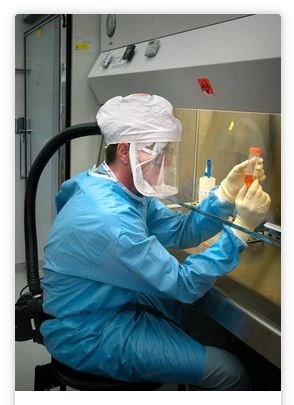An open letter to Dr. Terrence Tumpey, aka God
Dr. Terrence Tumpey
Aka God; Chief
Immunology & Pathogenesis Branch
Centers for Disease Control
1-800-CDC-God-666
Dear Dr. Tumpey,
Greetings, your Eminence! I hope the current pandemic finds you well.
It has just come to my attention that you performed a miracle in 2005—imbuing a computer model of the extinct Spanish flu virus with life. I apologize for the delay in recognizing your divinity. I have no idea how I missed this astounding news—unless maybe it happened that month I spent binge-watching Reno 911 and eating pizza and ice cream in my pajamas.
I’ve always said that if Jesus returned to this mortal realm, he’d be institutionalized. In fact, I met Jesus at least a dozen times while working in mental health facilities in college. If You are Him again, I’m glad to see you not only have looks, brains, and the power to bring forth life from computer code, but also a lucrative government job with fantastic benefits, and after your pension vests, a future in the vaccine industry so blindingly bright, you gotta wear shades. Kudos, your Eminence.
It was providence that you were The One chosen by then-chief fallen angel Gerberding to create life in the CDC lab—your sacrifices for sacred virology deserve high praise.
Dr. Terrence Tumpey at work.
“As part of security and safety considerations, CDC’s Office of the Director determined that only one person would be granted permission, laboratory access, and the tremendous responsibility of reconstructing the 1918 virus. That person was trained microbiologist Dr. Terrence Tumpey, who was approved for the project by then CDC director, Dr. Julie Gerberding.” (SOURCE)
“To reduce risk to colleagues and the public, he was required to work on the virus alone and only after hours when fellow colleagues had exited the laboratories for the day and gone home. A biometric fingerprint scan was required for access into the BSL-3E laboratory, and the virus storage freezers were only accessible via an iris scan of his eyes.” (SOURCE)
Trained seal postage stamp.
The story of your real-life adventure in sacred virology had me on the edge of my seat—it had more thrills than James Bond and more science fiction than Star Trek—at least, what I’ve read so far. The official account of the miracle, published by you and your apostles in the journal Science, is hidden behind a pay wall, and I’m still holding out hope that divine providence will deliver a free copy to my inbox.
“With the entire genome of the 1918 virus now sequenced, the necessary information was in place to reconstruct a live version of the 1918 virus.” (SOURCE)
“Using the completed sequence, another group of scientists at Mount Sinai created circular pieces of its DNA called plasmids. The plasmids for the 1918 virus were then sent to the CDC, where Dr. Tumpey inserted them into human kidney cells and used reverse genetics to reconstruct the complete 1918 virus. As part of the reverse genetics process, plasmids are placed into cells, where they instruct the cells to produce a complete RNA virus. Once the 1918 virus was fully reconstructed using this method, Dr. Tumpey and colleagues studied the live 1918 virus in the laboratory under strict biosecurity precautions, so as to better understand what made the 1918 virus so deadly and to inform global public health efforts to prepare for future pandemics.” (SOURCE)
“For multiple weeks in July 2005, colleagues and collaborators asked Dr. Tumpey if he had the 1918 virus and if it had appeared in cell-culture yet. […] On the day the 1918 virus appeared in his cell-culture, Dr. Tumpey knew history had been made, and in fact, a historic virus had been brought back from extinction. He sent a playful, Neil Armstrong-inspired email later that day to colleagues and collaborators, which simply said “That’s one small step for man, one giant leap for mankind.” Everyone then knew what had been accomplished. Dr. Tumpey had become the first man to reconstruct the complete 1918 virus.” (SOURCE)
Speaking of Neil Armstrong…what do you think he meant when he said breakthroughs are available to those who can remove one of truth’s protective layers?
I was super-impressed with your photos that clearly proved the Spanish flu virus you brought to life was hypothetically possibly an actual thing of some kind. Especially the pictures of the petri dishes—anyone can see there were a lot more blurry white patches in the Spanish flu dish. And there were a lot more dark spot thingies in the picture of the mouse’s lung. If that’s not proof you brought a dangerous extinct virus back to life, I don’t know what is.
I was shocked to learn that the sacred viral life you created was soon destroyed “as a safety precaution” (SOURCE).
I can only imagine how painful that must have been—after all those long hours, alone in your lab—and you finally created life, but it’s stripped away from you before any outsiders had a chance to examine your wondrous creation in detail. Science can be so cold.
Was the Spanish flu bug you imbued with life the same one Dr. Milton Rosenau studied in 1919, which he found could not be spread from person-to-person? (1)
Dr. Rosenau teamed up with officers from the U.S. Navy and U.S. Public Health Service to investigate how the flu spread. They had at their disposal the quarantine facility on Gallop Island in Boston Harbor, a hundred young and healthy Navy volunteers, and a large selection of very ill influenza patients at two area hospitals. They tried everything to spread the Spanish flu from patients to volunteers, including having the patients cough directly in their faces, and spraying their mucus directly into eyes, noses and throats. Nothing worked. It’s probably best the bug you gave life to was destroyed—the vaccine industry definitely doesn’t need that kind of negative publicity.
Tom Selleck
The main reason I’m writing is to ask you what progress has been made since 2005 in imbuing computer code with life. With our knowledge of the human genome, has science advanced enough since then to, say, bring a computer-generated image of Tom Selleck to life? I don’t mean “life” in the sense of having needs of his own—more like a low-maintenance android I can store in the closet when I want to be alone. I don’t have forever to make a semi-meaningful connection with a simulated human, and it has been over 15 years since your last known miracle.
With best regards and deep genuflection,
Virginia "Ginny" Stoner
Self-appointed Emissary of Snark
***
NOTES:
(1) EXPERIMENTS TO DETERMINE MODE OF SPREAD OF INFLUENZA, MILTON J. ROSENAU, M.D., JAMA. 1919; 73(5):311-313. doi: 10.1001/jama.1919.02610310005002 (Link)





